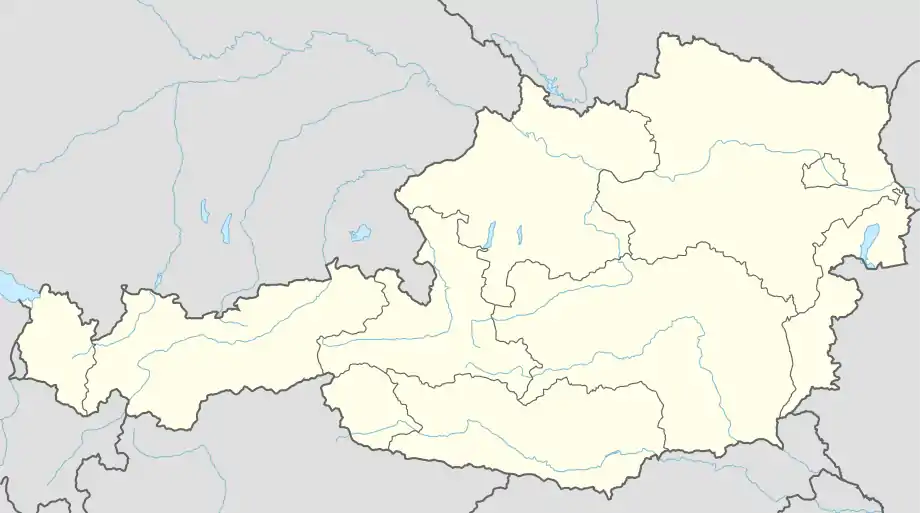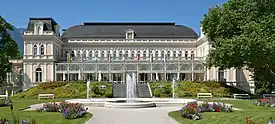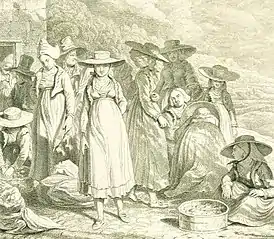Bad Ischl
Bad Ischl [baːt ˈɪʃl̩] is a spa town in Austria. It lies in the southern part of Upper Austria, at the Traun River in the centre of the Salzkammergut region. The town consists of the Katastralgemeinden Ahorn, Bad Ischl, Haiden, Jainzen, Kaltenbach, Lauffen, Lindau, Pfandl, Perneck, Reiterndorf and Rettenbach. It is connected to the village of Strobl by the river Ischl, which drains from the Wolfgangsee, and to the Traunsee, into which the stream empties. It is home to the Kaiservilla, summer residence of Austro-Hungarian monarchs Emperor Franz Joseph I and Empress Elisabeth. In 2024, Bad Ischl will be the European Capital of Culture – the third city in Austria after Graz (2003) and Linz (2009).
Bad Ischl | |
|---|---|
 | |
 Coat of arms | |
 Bad Ischl Location within Austria | |
| Coordinates: 47°43′13″N 13°38′0″E | |
| Country | Austria |
| State | Upper Austria |
| District | Gmunden |
| Government | |
| • Mayor | Ines Schiller (SPÖ) |
| Area | |
| • Total | 162.8 km2 (62.9 sq mi) |
| Elevation | 468 m (1,535 ft) |
| Population (2018-01-01)[2] | |
| • Total | 14,133 |
| • Density | 87/km2 (220/sq mi) |
| Time zone | UTC+1 (CET) |
| • Summer (DST) | UTC+2 (CEST) |
| Postal code | 4820 |
| Area code | 06132 |
| Vehicle registration | GM |
| Website | www.bad-ischl.ooe.gv.at |
History
Bad Ischl was a settlement area since the Hallstatt culture, first mentioned in a 1262 deed as Iselen. In 1419 Archduke Albert V of Austria established the local seat of the Salt Chamber (Salzkammer) at Wildenstein Castle, and Ischl was granted the privileges of a market town in 1466 by Emperor Frederick III. A first salt mine was opened in 1563, a salt evaporation pond (Saline) followed in 1571.
When in the early 19th century brine came into use for medical purposes, Ischl soon became a fashionable spa resort with notable guests like Prince Klemens Wenzel von Metternich and Archduke Franz Karl of Austria. The Hotel Post opened in 1828 was the first one in the whole Salzkammergut area. In 1849 Franz Karl's son, Emperor Franz Joseph I of Austria chose the town for his summer residence.
On 19 August 1853 the engagement between Franz Joseph and Elisabeth of Bavaria (Sisi) took place at the Seeauerhaus, Esplanade No. 10, which since 1989 has been the location of the Museum der Stadt Bad Ischl.
In 1854, the Emperor's mother, Archduchess Sophie, gave him the Kaiservilla (Imperial Villa) as a wedding present. The villa became the imperial family's summer residence; Franz Joseph described it as "Heaven on Earth".[3] He also granted a nearby mansion to mistress Katharina Schratt, that could be easily reached via a hidden footpath. In the Kaiservilla on 28 July 1914 Franz Joseph signed the declaration of war against the Kingdom of Serbia, signalling the start of World War I. He left Bad Ischl on the following day and never returned. The villa is still owned by the Habsburg-Lorraine family, although the grounds and parts of the residence are now open to the public.
In the aftermath of the defeat of Germany in World War II, Bad Ischl was the location of a displaced persons (DP) camp for survivors of the Holocaust and Nazi concentration camps in Eastern Europe. The resident displaced persons were primarily Jews from Poland and other neighboring countries. They were provided with lodging, food, medical care and administrative assistance until they were able to make other, more permanent arrangements. Many left for the United States, Israel and Canada. The Bad Ischl DP camp remained active from 1945 through 1952.
Population

| Year | Pop. | ±% |
|---|---|---|
| 1869 | 6,827 | — |
| 1880 | 7,678 | +12.5% |
| 1890 | 8,473 | +10.4% |
| 1900 | 9,655 | +14.0% |
| 1910 | 10,188 | +5.5% |
| 1923 | 10,224 | +0.4% |
| 1934 | 10,354 | +1.3% |
| 1939 | 10,396 | +0.4% |
| 1951 | 13,422 | +29.1% |
| 1961 | 12,703 | −5.4% |
| 1971 | 12,812 | +0.9% |
| 1981 | 12,970 | +1.2% |
| 1991 | 13,887 | +7.1% |
| 2001 | 14,081 | +1.4% |
| 2011 | 13,939 | −1.0% |
| 2015 | 13,813 | −0.9% |
Approximately 15% of the city's population was foreign born in 2019.
Sights


Besides the Kaiservilla, the city offers several health spas and tourist attractions, like the historic Kongresshaus opened in 1875, the new Kurhaus built by Clemens Holzmeister in 1932, as well as the Lehár Villa, the former residence of Franz Lehár, that he acquired in 1912 and today serves as a museum. The Saint Nicholas parish church was first mentioned in a 1344 deed.
Bad Ischl is also known for the Konditorei Zauner pastry shop, former k.u.k. purveyor established in 1832, and the small Lehártheater built in 1827.
A gondola lift runs from the town up to the Katrin alpine pasture at 1415 m (4643 ft), which offers a panoramic view of the Salzkammergut mountains. The ruins of Wildenstein Castle, which burnt down in 1715, are nearby.
The Bad Ischl Cemetery is listed by the State of Upper Austria as a protected historical site. Amongst those buried there are the composers Franz Lehár, Rudi Gfaller, and Oscar Straus.[4][5]
Notable people

- Helmut Berger, actor was born in Bad Ischl on 29 May 1944.
- Leopold Engleitner, conscientious objector, born in Aigen, Strobl am Wolfgangsee on 23 July 1905 grew up in Bad Ischl.
- Jörg Haider, politician (26 January 1950 – 11 October 2008) attended school in Bad Ischl.ط
- Leopold Hasner von Artha, politician, born in Prague on 15 March 1818, died in Bad Ischl on 5 June 1891.
- Wolfram von Richthofen, German Field Marshal, born in Germany on 10 October 1895, died, whilst being held in captivity at Bad Ischl on 12 July 1945.
- Franz Lehár, operetta composer, born in Komárno (now Slovakia) on 30 April 1870 died in Bad Ischl on 28 October 1948.
- Roger Lewis (b. 1960), British author, lives in Bad Ischl.
- Jacques de Menasce, composer, born in Bad Ischl on 19 August 1905
- Leo Perutz, author, born in Prague on 2 November 1882, died in Bad Ischl on 25 August 1957.
- Josef Plieseis Communist Widerstand fighter, born in Bad Ischl on 20 December 1913, died here on 21 October 1966.
- Oscar Straus, composer, born in Vienna on 6 March 1870, died in Bad Ischl on 11 January 1954.
- Viktor Schauberger (30 June 1885 – 25 September 1958) was an Austrian forester/forest warden, naturalist, philosopher, inventor and Biomimicry experimenter.
- Rudi Gfaller, Austrian composer and his wife, the operetta singer Therese Wiet lived in Bad Ischl for many years and are buried in the Bad Ischl Cemetery
See also
References
- "Dauersiedlungsraum der Gemeinden Politischen Bezirke und Bundesländer - Gebietsstand 1.1.2018". Statistics Austria. Retrieved 10 March 2019.
- "Einwohnerzahl 1.1.2018 nach Gemeinden mit Status, Gebietsstand 1.1.2018". Statistics Austria. Retrieved 9 March 2019.
- "Official Kaiservilla Homepage". Archived from the original on 13 June 2006. Retrieved 3 June 2006.
- s.n. (2019). "Friedhof Bad Ischl". Friedhofsführer. Ischler Heimatverein. Retrieved 22 July 2019 (in German).
- State of Upper Austria (21 June 2016). Unbewegliche und archäologische Denkmale unter Denkmalschutz, pp. 16–17. Retrieved 22 July 2019 (in German).
External links
| Wikimedia Commons has media related to Bad Ischl. |
- Bad Ischl's government website
- Bad Ischl Tourist Board
- https://web.archive.org/web/20160329155309/http://mariatheresa.com/sisielisabeth.html In 1854,the Imperial Villa at Bad-Ischl was given as a wedding gift to Franz Joseph by his mother.
